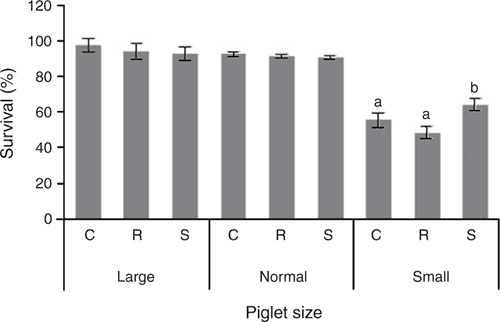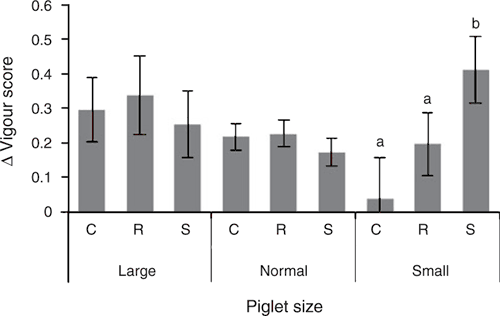Neonatal split suckling improves survival of small piglets
J. S. Huser A C D , K. J. Plush B , W. S. Pitchford C , T. E Kennett A and D. S. Lines AA SunPork Farms, Stirling, SA 5152.
B South Australian Research and Development Institute, Roseworthy, SA 5371.
C The University of Adelaide, Roseworthy, SA 5371.
D Corresponding author. Email: sophia@austporkfarms.com.au
Animal Production Science 55(12) 1477-1477 https://doi.org/10.1071/ANv55n12Ab079
Published: 11 November 2015
Split suckling (SS) is a management technique that could provide more sufficient colostrum to all piglets within large litters, thereby improving the chances of survival. The absorption of colostral IgG is essential for immune system development as there is no placental transfer of antibodies between sow and piglet in utero (Nguyen et al. 2013). This is achieved by reducing competition at the sow’s udder, which allows smaller piglets to consume adequate colostrum (Vallet 2013). This trial aimed to identify if two SS treatments would improve piglet survival under commercial conditions. It was hypothesised that split suckling will increase colostrum ingestion and reduce mortality in piglets.
The experiment was conducted at a commercial piggery using parity 0–7 litters (n = 423). Each litter was assigned to one of the following three treatments (n = 141 litters per treatment): control (no SS); rotational (half litter SS hourly for 4 hours); or SSam (separation of the largest piglets in a litter, allowing the smallest to suckle for 2 hours in the morning). Prior to any cross-fostering, piglets were tagged, weighed [piglets were classed as small (<0.85 kg), normal (0.86–2.07 kg) and large (>2.08 kg)], and subjectively scored for vigour (0–3 scale; adapted from Herpin et al. 1996). The SS treatments were then applied. On d 1 after farrowing, a blood sample was taken from four piglets (two heaviest and two lightest piglets) from each litter. Piglets were then re-scored for vigour, thereby enabling the change in vigour to be calculated. The blood sample was used for the estimation of colostrum ingestion (immunocrit technique; quantification of IgG in serum) (Vallet et al. 2013). Piglet mortality from birth to weaning was recorded to determine survival between the treatment groups. Traits were analysed with a generalised linear mixed model (SAS®; USA), with birth and rearing sow fitted as a random effect. Fixed effects included sex, piglet birth weight, litter size, sow parity, and SS treatment. Binary traits (survival) were analysed with a logistic transformation.
Survival of small piglets from the SSam treatment was 13% greater than small piglets in the control and rotational treatments (Fig. 1; P < 0.05). Change in vigour from d 0 to d 1 in small piglets from the SSam treatment was different by half a score from small piglets in the control and rotational SS groups (Fig. 2; P < 0.05). Colostrum absorption was similar among treatments and size classifications (P > 0.05). In conclusion, the data provides evidence that SSam improves the survival of small piglets through enhancing their vigour, though there was no overall effect of treatment on colostrum ingestion.

|

|
References
Herpin P, Le Dividich J, Hulin JC, Fillaut M, De Marco F, Bertin R (1996) Journal of Animal Science 74, 2067–2075.Nguyen K, Cassar G, Friendship RM, Dewey C, Farzan A, Kirkwood RN, Hodgins D (2013) Journal of Swine Health and Production 21, 139–143.
Vallet JL (2013) Control of Pig Reproduction IX, 225–226, eds H Rodriguez-Martinez, NM Soede, WL Flowers.
Vallet JL, Miles JR, Rempel LA (2013) Veterinary Journal (London, England) 195, 91–97.
| Crossref | GoogleScholarGoogle Scholar |
Supported by Pork CRC Limited Australia and Australian Pork Limited.


